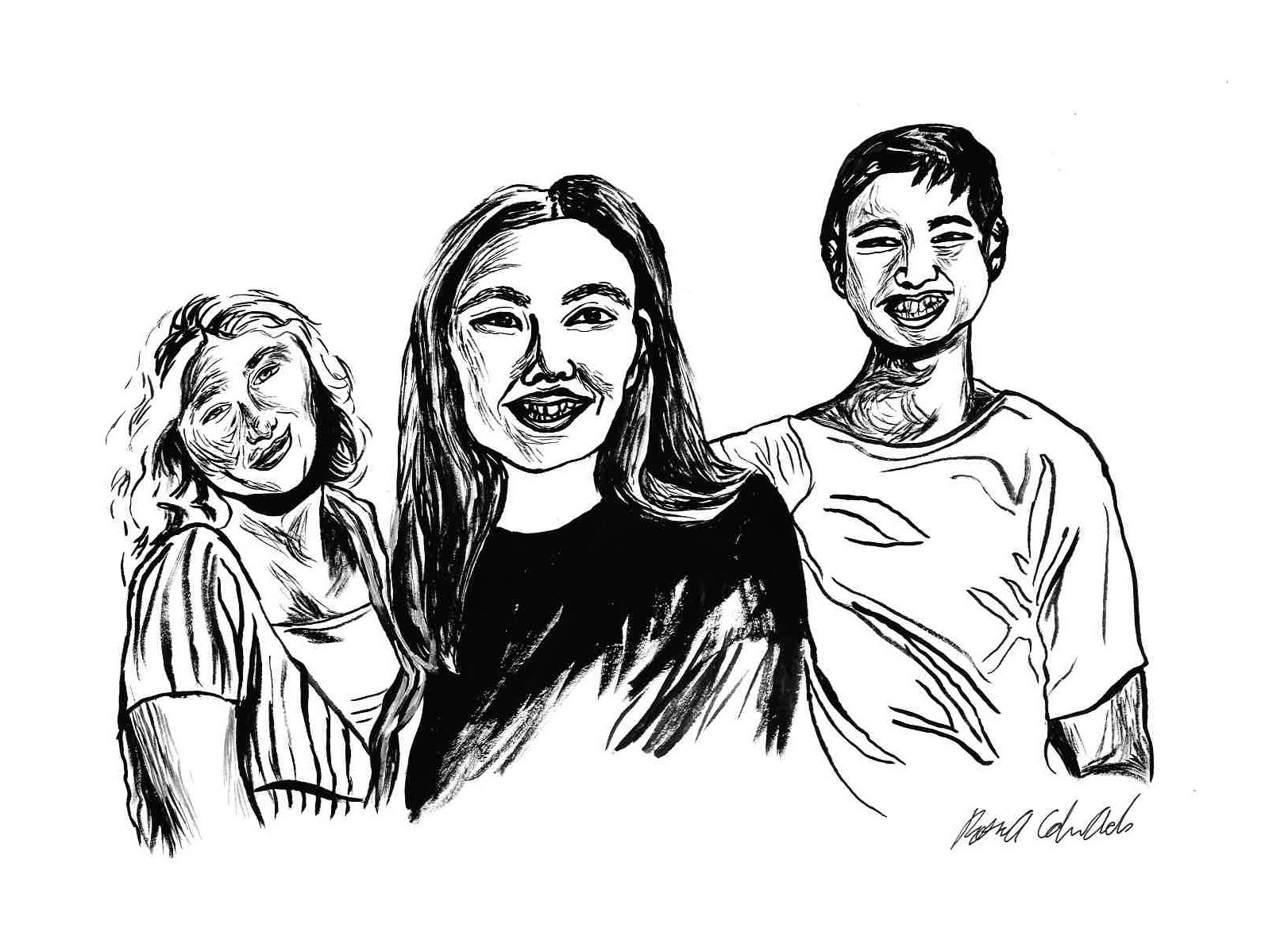Although Lick-Wilmerding is an academically rigorous school, a large part of students’ time here is spent not on schoolwork, but on navigating friendships and exploring their identities. A clique, according to the Oxford dictionary, is “a small group of people with shared interests or other features in common, who spend time together and do not readily allow others to join them.” Lick students describe cliques as a false stereotype of teen friendship, yet they also ackowledge navigating friend groups as an important part of navigating friendships. Lick students describe friendship as a way to explore and form their identities, both by seeking sameness and by seeking difference.
Lick community members have various definitions of friendship. Daniel Veal ’20 defines a friend as “somebody who you can trust, somebody who trusts you, somebody who you can always be real around.” Many community members also place value upon trust and openness.
Nathan Liang ’20 doesn’t require trust in a friendship; he extends his definition of friendship to “anyone I like being with.”
Sophia Patterson ’21 focuses her definition on the emotions involved in friendship, defining a friend as “someone who cares for you very deeply and who means well for you and someone who you can bond with.”
For Kyan Shlipak ’22, friendship is a balance between “someone you can trust and someone you can have fun with.”
For School Counselor Yuka Hachiuma, and Christine Godinez, Director of the Center for Civic Engagement, friendship is not just a passive activity, but instead a relationship that requires effort and mutual care. Friendship, according to Hachiuma, is “a connection that is shared between two people that can require effort to sustain… It should be mutually enjoyable and both parties derive a lot of fulfillment from being in the company of the other.”
A freshman said she observed friend groups forming around physical appearance and gender. At the beginning of frosh year, she observed three main groups of friends in her grade that split by gender: the freshman boys, and two groups of freshman girls. According to her, one of the groups of girls “was all wearing practically the same clothes. It was kinda scary almost… They all look like mirror images of the others.”
Naima Blanco-Norberg ’21 thinks that friendships are not made up of labeled groups. According to Blanco-Norberg, “everyone is different and no one likes being called a label.” Blanco-Norberg’s account of the Lick lunch scene initially seems similar to the labeled groups that she refuted: “People do have their designated places they eat, and designated people they eat with.”
The difference between the expectation of labeled groups eating lunch in a regular spot, and the reality, is subtle. These groupings are a means of exploring identity, and provide a space for teens that is stable and welcoming, at a time in their life when many things are constantly changing. For Blanco-Norberg, who often eats in the Center, “it’s really cool to have a space that I can always depend on … where I can always feel welcome.”
Unlike Blanco-Norberg, Felix Fein ’22 says that, although he has a core group of friends, he floats between many different groups. According to Fein, having many different friend groups has its benefits and its drawbacks. “You have lots of people that you can trust, but then also the other side of that is that you might not be quite as close with another friend group.” Fein’s experience of friendships steps outside the boundaries of cliques, yet he acknowledges that there is an expectation for students to be a part of specific groups in the Lick social scene. Like Blanco-Norberg, he uses getting lunch in the Cafeteria to describe the choices of friend groups at Lick. “You walk out, and it’s like, do you go here or here or here?”
While friendships in middle school are generally defined by conformity, high school friendships often shift their focus to emphasizing and expressing individual identity. Hachiuma says that high school friendships generally attempt to answer the question, “Who am I?”
In high school, friend groups can prompt students to consider their own individual identity. Sometimes students seek out difference and form their identity by standing out, while sometimes students seek out people who share their experience or a certain part of their identity.
Lick students come from a wide range of middle schools, families, and backgrounds. This contributes to the school’s “cultural, social, and socioeconomic diversity” according to the school website. The website states that 4%-17% of students will be first-generation college students and 33% of students are on financial aid. The student body is 5% South Asian, 8% Southeast Asian, 26% East Asian, 15% Latinx, 9% African American, and 44% White. The exploration of identity for Lick students is underlined by the navigation of the specific demographics of the school.
Fein, who came to Lick from a private school that was less diverse than Lick — both racially and socioeconomically — said that he noticed much more diversity upon coming to Lick. He said that “the diversity [at Lick] has opened my mind.”
While Fein experienced more diversity coming to Lick, Blanco-Norberg had a very different experience transitioning into the Lick community. Blanco-Norberg came from a charter school in the Fillmore where the majority of the student body was made up of people of color. It was hard for her to come to Lick, which has fewer students who share her identity and her experiences as a person of color growing up. At her old school, “there were many people who looked like me and who I could relate to in many different ways,” and so when she was first transitioning into Lick “it was hard to connect to people in the community.”
As Blanco-Norberg got older, she started hanging out with people with whom she shared experiences. “Being around people of color has really helped me self identify with experiences they’ve had and say ‘oh yeah I’ve been through that too.’” She has different friends for different commonalities: “One may be to talk about art, while another about sports, and another about social justice.”
Not only has she been able to identify and relate to the people around her through these friendships, but she has
also been able to learn about herself. Blanco-Norberg says that her friendships have “helped me understand my personal perspective and point of view a lot more and get to know who I am.”
While Blanco-Norberg became more comfortable with herself at Lick by surrounding herself with people with whom she shared experiences, Saijai Chaloemtiarana ’20 and Leah Atkins ’20 gravitated towards each other because of their differences. As Leah says, “we are very different people, but we have the same core values. And I think that’s why we are so close.”
According to Atkins, not only can people in friendships be different, but friendships themselves can be fluid and change: “friendships are changing and shifting because people don’t ever stay the exactly the same. As humans, our innate nature is to adapt and change and constantly figure out who we are and who we want to be. Genuine friendships will go along with that.”
The same freshman who noticed one group of frosh girls who all looked the same said that in middle school, she used to “self segregate to people who were like me and dressed like me and looked like me in a lot of ways.” She went to a public middle school in San Francisco and her transition into Lick was difficult. She found comfort in people who looked like her. According to this freshman, after three years of reflecting on her identity and how it related to others, only sticking with people who look me was “not a good mindset because people should not be looking for people who look exactly like them. It’s not a good way to find comfort.”
Atkins’s transition into Lick has allowed her to think about her identity in a new way, and to ask, “Where do I fit in here?” As she observes the social dynamics around her, she is also exploring her own identity and how that identity fits into the larger Lick community. Although she thinks that comfort should not only be found in people who look like her, she does acknowledge that she still finds comfort in people at Lick who are also former public school students. “I feel like, I can get this under control, because they’re going through a similar experience as me and it’s therapeutic to be able to rant with them.”
Godinez runs the peer connect program, which pairs incoming frosh with upperclassmen and organizes events and games for the mentees and mentors. Godinez says that friendships form around common experiences, but those experiences do not just have to be about core identifiers.
According to Godinez, shared creativity is one of the best ways to make friends. She says that “when there’s a common project or goal or something you can do creatively, that’s when you find commonalities.” Godinez thinks that groups of friends that form around shared experiences or interests are important, as long as individuals in the groups branch out. The issue with rigid groups of friends, she says, is that they block other friendships from forming: “There are people here who you could be best friends with, but [who] you don’t give the time of day, because they don’t look like you, because they come from different socioeconomic backgrounds.”
Godinez thinks of the ideal Lick community like she thinks of the ideal advisory, the community developed over four years by the twelve students of the group who meet together twice a month to reflect on their own growth and on their community. “I like to think of advising as a family. You don’t always like everyone in your family, but you respect them, and you do have love for them. [The student body would be more willing to branch out] if everyone could see each other as family, not always friends, but have that mutual love and respect.”







